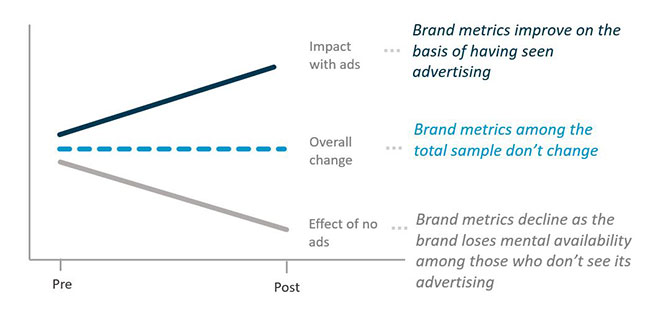SPONSORED CONTENT
How strong research design can provide more actionable insight
Jeri Smith
CEO, Communicus
Of all the research questions faced by today’s Insights teams, one that should be very straightforward is actually one of the hardest. The question:
“What’s our advertising doing for our brand?”
Why is this question so difficult to answer – or to answer well? Here’s why:
- There are many things that impact your brand besides your ads. Thinking that your ad-tracking study will tell you how your advertising is working reflects a highly advo-centric view of the world.
- Consumers can’t really tell you whether they’ve been influenced by advertising or what caused them to choose one brand over another. Much of advertising’s impact takes place in the System 1 brain (Figure 1). Over time, with multiple exposures to multiple ads, the consumer might start to think differently about the brand and this might result in changes in brand attitudes or actions.
- If your brand’s advertising team has been riding the wave of new media platforms, there are lots of different ads that your consumer might (or might not) have seen. You need to know which ads worked. And since in the mind of the consumer it all aggregates up to overall brand impressions, examining one ad at a time isn’t going to capture the way the different pieces work together to produce results.
- An ad that produces a bump in short-term sales might not be the same ad that contributes to the brand’s long-term health. To help your brand grow in the longer term, you owe it to the brand to ensure that your focus isn’t solely on short-term sales.
Figure 1: How advertising works to build brands in the System 1 brain

Okay, it’s hard. But it needs to be done.
Here are some means by which these challenges can be overcome with strong research designs. Here’s how you can become the hero who’s providing correct, comprehensive answers to the question, “What’s our advertising doing for our brand?” and also providing actionable insights into, “Which ads?” and, “What could be done to make the advertising work harder?”
Challenge No. 1: Sorting out the changes that have been produced by advertising from the changes that are a result of other factors
A good campaign shifts attitudes and behaviors among those who’ve seen it. And if it’s a good campaign that’s well-funded and well-placed a lot of people will see it. But even the best campaign won’t be seen by everybody. And usually, the brand begins to lose mental availability and preference among those who aren’t seeing the brand’s advertising. Brand tracking that doesn’t account for what’s happening among people who haven’t seen your campaign will nearly always understate the true impact of advertising.
To solve for this requires a test/control design. But anyone who’s tried to run test/control market advertising tests has discovered that there’s usually so much noise in the data that it’s nearly impossible to determine the lift produced by advertising.
A better way is to use a longitudinal design in which the same people are interviewed before and after the advertising has appeared in-market as a kind of self-selecting test. Those who haven’t seen the campaign serve as the “control,” representing a proxy for what would have happened to the brand without advertising. Examining the change over time among those who’ve seen the advertising versus the change that has occurred among those who haven’t seen the advertising can provide insights into what the campaign accomplished.
Generally, those who haven’t seen the advertising show declines (Figure 2). Advertising often works to offset these declines – this is the “defensive” role of advertising. Even in cases where overall brand health is not increasing over time, the campaign may be working to keep the brand’s mental availability from declining.
Figure 2: Isolating Advertising Impact

Challenge No. 2: Figuring out how consumers really feel about your brand and whether seeing ads has changed that
People are good at telling you how they feel right now. What they can’t tell you about is their motivations – why they like a particular brand, whether a particular ad persuaded them or what would persuade them to behave differently. So we can’t ask them about ad persuasion; rather, we need to observe ad persuasion using implicit means. The longitudinal design gives us a powerful way of doing that – observing how people have changed over time and what types of changes are associated with having seen different ad messages.
For this longitudinal design to work, you need to figure out who’s seen the ads. Not an easy task.
Challenge No. 3: Sorting out which ads and which media platforms have contributed
Consumers can’t tell you (at least not without help) what ads they’ve seen. In theory, exposure-based (or opportunity to see) systems can help.
But wait. We know that not all exposures result in attention being paid to the ad. In fact, most ad exposures go completely unnoticed. So if you’re assuming someone “saw” an ad who actually didn’t, you’ll mis-categorize people as “ad aware” who actually weren’t, confounding the ability to quantify the impact of the campaign.
We need a better way of figuring out who’s seen ads and which ads they’ve seen. For this, it turns out that appropriate memory triggers work really well to identify those who’ve seen a particular ad in-market. When the memory triggers used match how the ad memories are stored for a particular type of ad, we can sort people into those who’ve seen ads versus those who haven’t with at least 90 percent confidence. These memory triggers, matched to how different types of memories are stored, provide a media-agnostic method for determining ad awareness. No longer are we tilting the scales in favor of memories that are easier to access, like recent TV spots, versus those that are buried deeper, like the Pandora spot you heard last month. Likewise, we aren’t tipping the scales to favor exposure opportunities that are easier to capture, like online exposures, versus exposure opportunities in media types that are more challenging to capture.
With this ability to categorize people based on what ads they’ve seen, we can create a true cross-platform measurement system. This enables us to understand not just whether advertising worked but which ads worked.
Further, with this comprehensive data set, we can develop an understanding of the combination of ads and messages across platforms that had the greatest impact on the brand.
Challenge No. 4: Quantifying both short-term and long-term advertising impacts and creating a comprehensive understanding that encompasses both
In today’s world of quarterly earnings reports and short-term CMOs, it’s hard to focus beyond the immediate effectiveness of advertising. But if all that mattered was short-term results, all ads would contain offers and deals. Thoughtful, responsible marketers understand that their campaign should also support brand health. The trick is to balance the two needs and for research that provides insights into both.
Using the longitudinal design approach to examine change at the top of the purchase funnel (awareness, overall impressions) and then all the way down through brand attitudes, then to purchasing behavior and loyalty, enables the insights manager to quantify and diagnose the success of the advertising at each stage and its ability to lead the consumer down the path-to-purchase.
A campaign that only produces favorable impressions but fails to generate short-term sales is bad but so is a campaign that only generates short-term sales but does not support brand health. We owe it to the CMO to ensure that our research tells the full story, which cannot be done with sales data or attribution modeling alone.
Answering the question, “What’s our advertising doing for our brand?” may not be as hard as it seems. Thoughtful approaches to study design, proven questioning and analytic methodologies, overlaid with a solid database and deep experience, can light the way.

www.communicus.com
info@communicus.com
520-751-9000
